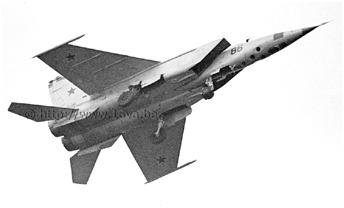
 Bill Burhans served as a tour officer with the USMLM Air Team from July 1971 to June 1975. He returned in 1979 to command Detachment 16,
7113th Special Activities Squadron (the Air Team), departing in early spring 1980 following a December 1979 Soviet-originated nasty incident.
He recalls for us how the USMLM tried to get the first photographs of the new MiG-25
on the day of their arrival at Werneuchen.
Bill Burhans served as a tour officer with the USMLM Air Team from July 1971 to June 1975. He returned in 1979 to command Detachment 16,
7113th Special Activities Squadron (the Air Team), departing in early spring 1980 following a December 1979 Soviet-originated nasty incident.
He recalls for us how the USMLM tried to get the first photographs of the new MiG-25
on the day of their arrival at Werneuchen.
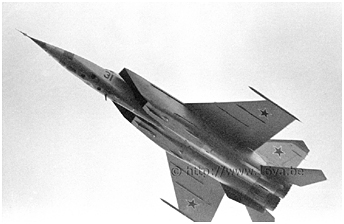
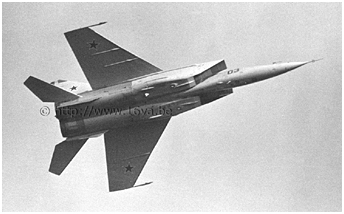 One of the most frustrating reconnaissance tours in which I ever can remember participating
took place one day in November 1974. From TAREX, the excellent notification system
introduced in Berlin in the early 1970s, we received a tip-off that the MiG-25 FOXBAT
reconnaissance platform was expected to be delivered that particular day to Werneuchen Soviet
Airfield located slightly northeast of Berlin.
Although bearing the innocuous title "Target Exploitation", TAREX actually functioned as a
fusion center manned by intelligence specialists with access to all-source information. These
experts were able to sanitize very sensitive intelligence information and provide it to the Air
Team, which facilitated our operations by allowing very precise targeting resulting in optimum
employment of our rather limited collection assets.
The 931st Separate Guards Reconnaissance Aviation Regiment subordinate directly to the
16th Air Army Headquarters was based at Werneuchen. Apparently this unit was about to
upgrade to a new aircraft, one of exceptionally high interest to the US intelligence community,
an aircraft that never had been seen in the Forward Area prior to this time.
One of the most frustrating reconnaissance tours in which I ever can remember participating
took place one day in November 1974. From TAREX, the excellent notification system
introduced in Berlin in the early 1970s, we received a tip-off that the MiG-25 FOXBAT
reconnaissance platform was expected to be delivered that particular day to Werneuchen Soviet
Airfield located slightly northeast of Berlin.
Although bearing the innocuous title "Target Exploitation", TAREX actually functioned as a
fusion center manned by intelligence specialists with access to all-source information. These
experts were able to sanitize very sensitive intelligence information and provide it to the Air
Team, which facilitated our operations by allowing very precise targeting resulting in optimum
employment of our rather limited collection assets.
The 931st Separate Guards Reconnaissance Aviation Regiment subordinate directly to the
16th Air Army Headquarters was based at Werneuchen. Apparently this unit was about to
upgrade to a new aircraft, one of exceptionally high interest to the US intelligence community,
an aircraft that never had been seen in the Forward Area prior to this time.
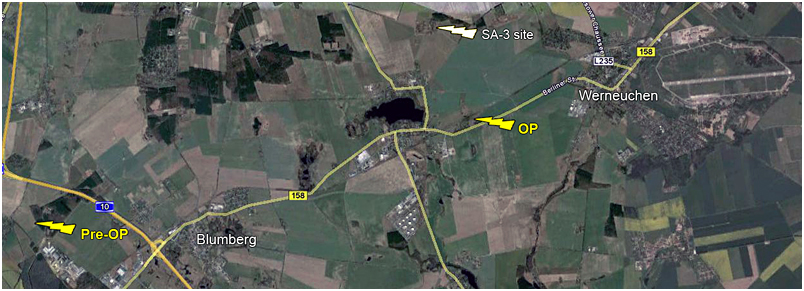
Master Sergeant Konrad Spitzenberger (Spitz) and I were the designated stand-by response team, so we were assigned this tip-off reconnaissance mission. Werneuchen was a very difficult base to cover. First, the airfield itself was deep in a Permanent Restricted Area (PRA). According to the official Soviet-issued map, the PRA included all the territory east of Autobahn A10 (the Berliner Ring, designated by the blue digits 10 in the above photo) in that immediate area. Second, that PRA boundary severely limited access to a very few viable observation points (OP); these locations were at the juncture of two Autobahn in close proximity to the northern outskirts of East Berlin. Third, about the only way into the area was via the Berliner Ring, making the tour vehicle quite vulnerable to detection. And, to make matters even worse, these OP were a long way (about 8 miles) from the western end of the Werneuchen runway, so we could not expect to get very good pictures from those positions. Spitz and I were fortunate enough to arrive in a preliminary OP (pre-OP) without attracting any attention. We set up on a hill along a tree line in an area at a relatively high elevation screened somewhat from nearby road traffic. We waited and waited for the predicted activity to occur. The weather was not great, the clouds were pretty low and lighting conditions were poor. We waited in that pre-OP for what seemed like eternity, keeping an eye out and ears alert not only for the possible arrival of narks (Stasi surveillance personnel), but for flying activity.
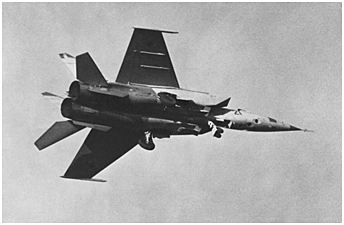
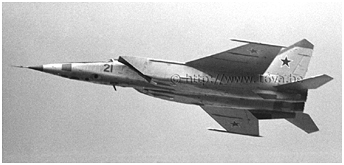 Suddenly, Spitz shouted that he saw an aircraft approaching! As luck would have it, I was
away from the tour vehicle (and my cameras), answering a call of nature at that very moment. I
dashed back to the car, tucking things quickly into my pants as I ran. I was able to grab my
camera with the Nikon 1000mm lens and succeeded in snapping off a few frames as the aircraft
passed overhead.
We were very surprised by that one FOXBAT approaching from a westerly direction for a
landing to the East. Neither of us recall hearing any engine run-ups and, therefore, we did not
expect a sighting at that time. Nevertheless, we got photos of that one rather distant bird...
It was evident the image size would be insufficient to do much good. But, we had at least
accomplished one thing - we took the first USMLM picture of the new FOXBAT in the
Forward Area. Both Spitz and I assumed we had seen the lead aircraft that was checking the
weather and en route conditions. The remaining aircraft in this deployment surely could not be
too far behind this pathfinder.
By this time, we had been in that OP for quite a long time and there was absolutely no one
around. I looked at Spitz and he looked at me. Let's do it! We jumped into the vehicle and made
a beeline for Route 158 and the town of Blumberg. We needed to get much closer to the airfield.
Naturally, this took us into the PRA, but we were operating under the well-known dictum-high
risk, high gain. This was a very high-priority target, all conditions were right, so we took a
calculated risk.
I made the decision that day to penetrate the PRA using as my rationale the fact that this was
a vital target, information for which higher authorities at the Washington DC level were
clamoring. To the best of our knowledge (and, as it turned out, we were absolutely correct), we
were not under surveillance.
Suddenly, Spitz shouted that he saw an aircraft approaching! As luck would have it, I was
away from the tour vehicle (and my cameras), answering a call of nature at that very moment. I
dashed back to the car, tucking things quickly into my pants as I ran. I was able to grab my
camera with the Nikon 1000mm lens and succeeded in snapping off a few frames as the aircraft
passed overhead.
We were very surprised by that one FOXBAT approaching from a westerly direction for a
landing to the East. Neither of us recall hearing any engine run-ups and, therefore, we did not
expect a sighting at that time. Nevertheless, we got photos of that one rather distant bird...
It was evident the image size would be insufficient to do much good. But, we had at least
accomplished one thing - we took the first USMLM picture of the new FOXBAT in the
Forward Area. Both Spitz and I assumed we had seen the lead aircraft that was checking the
weather and en route conditions. The remaining aircraft in this deployment surely could not be
too far behind this pathfinder.
By this time, we had been in that OP for quite a long time and there was absolutely no one
around. I looked at Spitz and he looked at me. Let's do it! We jumped into the vehicle and made
a beeline for Route 158 and the town of Blumberg. We needed to get much closer to the airfield.
Naturally, this took us into the PRA, but we were operating under the well-known dictum-high
risk, high gain. This was a very high-priority target, all conditions were right, so we took a
calculated risk.
I made the decision that day to penetrate the PRA using as my rationale the fact that this was
a vital target, information for which higher authorities at the Washington DC level were
clamoring. To the best of our knowledge (and, as it turned out, we were absolutely correct), we
were not under surveillance.
Also, I already had been promoted to the grade of Major and, had we been detained there, although I certainly would have been declared persona non grata (PNG), no longer able to collect intelligence in East Germany and reassigned to another job somewhere outside USMLM (in other words, fired!), that was not an overriding consideration. It would have not been that much of a black mark on my career anyway, as many would look upon my having been PNG'd as a badge of honor. Looking back now more than 35 years later and studying my decision, I realize I had failed to consider the fact that the chances also were very good that Spitz would have been PNG'd as well. That would have been a serious blow to the Air Team. It should be noted here that, during his five years of service with the USMLM Air Team, Spitz received two promotions and three awards of the Meritorious Service Medal awarded for outstanding service, as the name implies. However, in the case of this intrepid non-commissioned officer and superb intelligence collector, two of these awards were for achievement, and richly deserved. We were not far from one of the bridges over the Autobahn, and crossed over to the East side into the PRA toward the airfield. Neither of us had ever been inside PRA in this area. We did not know much about the terrain, but we knew by the map that we would have to drive near the Werneuchen SA-3 SAM site to get close to the airfield. We also could see from our map that we would have to cross the railroad tracks in two different places, the first just east of Blumberg and the second east of Seefeld. Fortunately, both were unguarded crossings so we did not attract any attention.
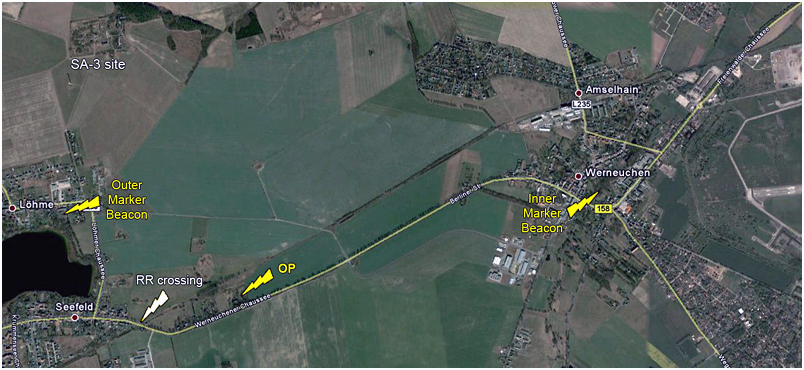
About 10 minutes had elapsed since we had seen that first aircraft. We found ourselves in a wide-open area just east of Seefeld that provided a lot of room to run. We were in one of our trusted four-wheel drive Ford Broncos. It is important to note here that this vehicle provided a modicum of security in and of itself, because externally it very closely resembled the UAZ-469 Soviet Jeep that rapidly was coming into the GSFG vehicle inventory at this time. Both of us felt pretty secure parked on a small hill from where we could check for surveillance, this being about 1¼ miles away from the SA-3 site. The outer marker beacon was about 1 mile away. We kept on seeking a good OP from which we would be able to see the airfield and remain in the line of flight of any aircraft on final approach. We were hoping now to be able to photograph the rest of the aircraft we had been told were to arrive that day. They would be passing over the outer marker beacon at an altitude of about 600 meters or a bit less than 2000 feet. We would have been able to see the airfield a bit more than 2 miles away had the weather not suddenly played a trick on us. The ceiling dropped, fog started to develop in the low spots and things remained very quiet. Alas, that delivery apparently was not to be. We waited and waited, and nothing happened. We finally threw in the towel and decided to leave the area. We had been very fortunate not to have attracted any attention up to this point. We certainly had no desire to further push our luck and be detained inside the PRA for nothing and run the risk of expulsion from USMLM.
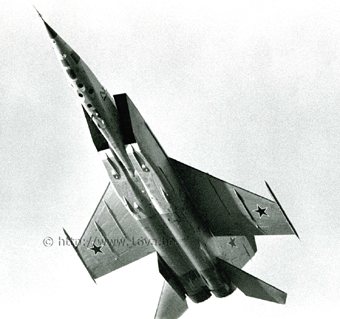
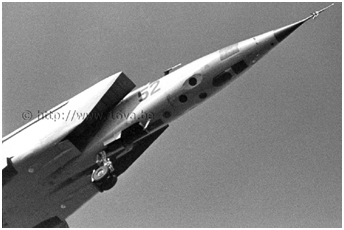 We climbed into the trusty Bronco. Spitz turned the key to start the engine, but nothing
happened, not even a click. Broncos were always our choice of reconnaissance tour vehicles and,
if given a choice between one with a standard or an automatic transmission, Spitz preferred the
standard shift. As it would be, we had an automatic that day and, even though we were up on a
hill with enough slope to coast down to start an engine on a standard-shift Bronco, we did not
have this option, which made our presence in the PRA just a slight bit less comfortable!!
After some of checking under the hood, primitive testing and rummaging in his tool bag for a
suitable device to connect the terminals of the starter solenoid, Spitz, who was a wizard around
motor vehicles and capable of fixing just about anything, succeeded in getting that good old 302
CID V-8 engine fired right up. We had an short uneventful ride back to the bridge over the
Berliner Ring and out of the PRA. Since this was a tip-off mission, we had no other target so
immediately returned to Potsdam to report in, and then continued on to West Berlin.
The next day, we learned that the deployment had in fact taken place. The kicker here was
that the remaining pilots, apparently not familiar with the airfield area, had been ordered to make
a straight-in approach from the east with the wind rather than employing the normal box pattern
approach with landing into the wind. We had done everything right, but the bad guys had thrown
us a curve!
Not long after our disappointing effort described above, my colleague and good friend Larry
Patterson, with superb support from Spitz, obtained the outstanding photograph above left showing
the photoreconnaissance version of this extremely high priority intelligence target.
We climbed into the trusty Bronco. Spitz turned the key to start the engine, but nothing
happened, not even a click. Broncos were always our choice of reconnaissance tour vehicles and,
if given a choice between one with a standard or an automatic transmission, Spitz preferred the
standard shift. As it would be, we had an automatic that day and, even though we were up on a
hill with enough slope to coast down to start an engine on a standard-shift Bronco, we did not
have this option, which made our presence in the PRA just a slight bit less comfortable!!
After some of checking under the hood, primitive testing and rummaging in his tool bag for a
suitable device to connect the terminals of the starter solenoid, Spitz, who was a wizard around
motor vehicles and capable of fixing just about anything, succeeded in getting that good old 302
CID V-8 engine fired right up. We had an short uneventful ride back to the bridge over the
Berliner Ring and out of the PRA. Since this was a tip-off mission, we had no other target so
immediately returned to Potsdam to report in, and then continued on to West Berlin.
The next day, we learned that the deployment had in fact taken place. The kicker here was
that the remaining pilots, apparently not familiar with the airfield area, had been ordered to make
a straight-in approach from the east with the wind rather than employing the normal box pattern
approach with landing into the wind. We had done everything right, but the bad guys had thrown
us a curve!
Not long after our disappointing effort described above, my colleague and good friend Larry
Patterson, with superb support from Spitz, obtained the outstanding photograph above left showing
the photoreconnaissance version of this extremely high priority intelligence target.
 |
Plan du site - Sitemap |  |

